Let's talk tomatoes
For many keen vegetable gardeners’ summer is all about tomatoes. Planted in spring or early summer they are among the most rewarding of crops and a source of great pride. In search of some timely tips, we checked in with three experienced Kiwi gardeners, growing tomatoes in very different climates.
In AUCKLAND, Dan Featherstone shares a much-loved cottage-style garden with his partner, Ann Nicholas. At any time of year, the couple’s town-sized section teems with colour and abundance, both floral (mainly Ann’s domain) and edible (mainly Dan’s). But right now, you can’t miss their tomatoes.
Dan has been growing tomatoes almost every year of his life since age of thirteen, when he learned the love of gardening from his dad in a large Mt Eden vegetable garden that fed a family of ten. For Dan, that distinctive tomato aroma is the smell of spring. It takes him right back to his youth and his after-school job in a Dominion Road plant shop, bundling and wrapping seedlings for customers.
“I love home grown tomatoes for their freshness, sweetness and volume! We eat them in and on everything in the summer. We also make all our own sauces, so we need the volume,” says Dan.
Which is lucky, because Dan loves growing tomatoes as much as he loves eating them. The luxury of a warm frost-free climate allows him to plant early. This year he got started in August, glad to have purchased some plants before lockdown happened. He likes to try new varieties every year. This year he reckons he’s planted about ten different varieties, including ’Super Beefsteak ’ , his all-time favourite large tomato, sweet medium sized Campari and the latest black tomato, ‘Yoom’. He has planted cherry tomatoes in every colour and recommends ‘Kumato Grape ’ a small dark flesh tomato that is very sweet.
In WELLINGTON, Frances grows tomatoes mainly in large pots. Apart from a shortage of space for vege beds, she has opted for pots because she can easily control where they are positioned for best sun and shelter from the Wellington wind. It also helps with disease control. “I had stem rot on tomatoes growing in the ground a few years ago so using pots avoids this,” she says.
“I grow tomatoes for the sheer joy of going into the garden to pick my own,” says Frances. “Even though when mine are ripe, tomatoes are cheap as chips to buy, store bought just don ’t compare.” She also likes the challenge of growing tomatoes in her less than perfect, town-sized garden, and has learned a thing or two about growing tomatoes on a slope and in the wind.
“When I plant into the garden, I put a large black pot that has the base cut off it, as a protective collar around the plants. This provides a modicum of protection from the wind without sheltering the plant completely, so it has a chance to harden to the conditions. When the plant has grown sufficiently tall and strong, the collar can be removed. I do the same with zucchinis and cucumbers.”
Frances recommends the variety tomato Flavoursome from the ican range, for taste, prolific fruiting and strong, healthy growth. She says the seed germinates easily and fruit develops quickly.
She also likes to try something new, saying, “This year it’s ‘Sweet Million’ and ‘Chocolate Sprinkles’ from Egmont Seeds.”
In NORTH CANTERBURY, Jenny Cooper and Chris Raateland’s magnificent garden has featured in glossy magazines and was a highlight in the recent Hurunui Garden Festival. Although less than a tenth of the 4600 square metres they garden is planted in fruit and vegetables, Jenny says the productive part of the garden is by far the most time consuming.
“It takes some work and skill to keep it both high yielding and manageable. I’,m really careful not to take on too much.” For that reason - unlike many South Islanders who grow tomatoes under cover - Jenny has decided against a glasshouse. But this hasn’t stopped her growing tomatoes successfully in the shorter South Island summer.
“We window-raise most of our tomatoes from seed, and sometimes buy a little punnet of extra seedlings to grow on. Then, while they get going outdoors, I use glass panels to keep them warmer and keep any late frosts off. I want them to grow on unchecked.”
Tomatoes take some effort with staking and pest control but they are really worth it. Having an endless summer supply is so handy, and we get through a mountain of them, which we wouldn’t buy if we didn’t grow.”
Jenny trials a range of varieties. “We want flavour most of all, and we don’t like watery toms,” she says. This year she is growing some gifted heirloom tomatoes. “And one of my faves, which I've bought for many years, is plain old ‘dwarf’ tomato. It is great for growing free-standing (without a climbing frame) in the interplanted beds. It’s very meaty, very flavoursome, cooks well, and it crops like mad for me right up until the frost begins.”
“I have to say by autumn, tomatoes are not the prettiest crop and it is always a relief to pull out the very last ones. But I love having big bowls of ripening tomatoes all over the kitchen. Our favourite thing is grilled or roasted tomatoes, halved, seasoned, maybe a bit of balsamic and sugar - yum! Can’t wait!”
Pests and disease issues
Right now in Canterbury, as in other hot dry regions Tomato and Potato Psyllid (TPP) is making its presence felt. In fact, “Psyllid is our only real problem on tomatoes, apart from the dry,” says Jenny. “It arrived here about four years ago. Since then I have stopped growing potatoes, as they are also a host, and I chose the toms over the spuds. We also remove deadly nightshade (also in the tomato family) when we find it, but I can’t remove it from the whole of North Canterbury!” she laughs.
To help fight the psyllid, Jenny tries to spray regularly with Naturally Neem oil. “It works if I do it often enough, but there lies the problem - spraying is my least favourite thing,” she admits. “I know I should use insect netting (to stop adult pysllid laying eggs on plants) but it is another thing to deal with, so I’ll look the other way for now - maybe at a flower!”
She has had some luck with interplanting, growing tomatoes amongst other plants, in a mixed vege garden along with flowers and herbs. “It’s slightly messy, and not as easy for picking and weeding, but it does seem to keep the psyllid pest at bay for longer.”
Lucky for them, neither Dan nor Frances report such trouble with psyllid. Frances thinks perhaps it’s because they don’t like Wellington’s weather. “I’ve been lucky. I’ve only had this pest once, and I ended that season by burning all the remains of the plants. Maybe the wind and coastal conditions in this area puts them off. Also, there’re not many other vege gardens in the neighbourhood for the psyllid to be attracted to.”
Green looper caterpillar (arising from the Diamond-back Moth) is Frances’ most destructive insect pest. “As soon as I spot the holes and the frass (insect poo), I go searching and pick them off.” She deals with blossom-end rot, a physiological disorder, by keeping an eye on the watering (not too much or too little) and adding a touch of lime to balance the soil’s acidity.
In Auckland, Dan faces “The usual blights, caterpillars and whitefly.” To control whitefly and other sucking insects he relies on regular applications of Naturally Neem and for caterpillar control he has recently started using organic Bactur from Grosafe, with great success.
“To prevent blight and other diseases I give early season copper sprays, generally twice, and always avoid wetting the leaves ay watering time. I also use crop rotation, planting my tomatoes in a different bed each year, or I’ll fill a bed with fresh planting mix.”
Feeding
Dan, who plants in raised garden beds plied with fresh compost every spring, says it’s hard to overfeed tomatoes, because they are such vigorous prolific growers.
“I believe feeding is the key to help keep the bugs away and keep plants thriving,” he says. "Preparation is key. It takes me a good month before I start planting, by the time I have limed the ground, then added balanced fertiliser a couple of weeks later.” He uses hydrated lime to help discourage soil borne wilt disease but warns that it must be used with caution as it is very reactive and can burn the skin.
These days Dan’s favourite fertilisers are fish based. Once his tomato plants are flowering, he feeds them some more. During flowering and fruiting he will liquid feed every two weeks. Liquid blood and bone is a favourite 'go to’ fertiliser and he sometimes uses worm tea.
For tomatoes in pots, Frances uses slow-release fertiliser, ican Slow Food, at planting time followed by and weekly applications of ican Fast Food liquid fertiliser or Yates Thrive Fish & Blood & Bone. If planting in the garden she digs in lots of compost and a good organic based fertiliser such as Yates Dynamic Lifter.
Jenny and Chris follow Charles Dowding’s No Dig gardening methods. “It’s a much easier way to garden and our crops are a good big size,” says Jenny. They make their own compost and apply it as mulch every time they harvest and replant any vegetable crop.
Jenny’s tomatoes also get fish fertiliser during the growing season. Sometimes she uses sheep manure, “If I can be bothered climbing under someone ’s sheep shed!” She no longer uses seaweed, explaining, “I ’m not sure how sustainable it really is, and I hate the thought that some developing country is losing its ocean ecosystem to the developed world ’s craving for seaweed.”
Watering
Watering is critical, especially for tomatoes growing in pots. Frances says she waters every day in hot or windy weather and adds “To prevent pots drying out it’s important to use large pots and the best quality potting mix you can get. I place them where they get plenty of sun but keep them out of the wind.”
Dan waters his raised tomato beds up to twice a day during summer when the plants are loaded with fruit but, “During spring I ’ll water the young plants if we have a dry spell but it ’s better to water deeply and infrequently at this stage because you want to encourage their roots to grow deep down into the soil.”
All three gardeners say they prefer to hand water, taking care not to wet the foliage. Jenny enjoys watering early in the morning at first light, “While still in a dressing gown with a cuppa!”
And wherever you grow them, deep planting helps anchor tomato plants and enhances their water and nutrient uptake. “Bury the stem to at least the level of the old seed leaves (cotyledons, which are the first leaves),” says Frances. “The stem below ground will form roots to anchor the plant and absorb more nutrients and water.”
Jenny agrees. “I plant all my seed raised tomatoes really deep, well over the bottom leaves, and they grow extra roots all the way up the stem.”
Support structures
Tying tall growing tomatoes to a support keeps plants off the ground ensuring plenty of air movement to minimise disease.
Jenny and Chris have attached permanent builders steel mesh to their fences as support for tomatoes and other tall growing plants. “I find this much easier to manage than stakes, especially when the norwester blows, and it looks great too,” says Jenny.
Frances has discovered the perfect stakes for her potted tomatoes. “I have these amazing steel spiral stakes that the plants can be wound up as they grow, with no need for ties. Unfortunately I don ’t have enough for all my plants so I also use bamboo stakes with soft cloth ties. As the plants get taller, they can tend to bend sideways in the wind so I devised some wooden braces to connect the tops of the stakes and keep them spaced and upright.”
Dan also uses single stakes which he says need to be strong and solid to handle the full weight of his plants. For large, grafted plants, he uses trellis or netting fixed firmly to sturdy posts.
With maximum productivity and disease control in mind, he is particular about training his tomato plants. “They always have their laterals (side shoots) removed, as I find this gives the best fruit quality,” he says. “On grafted plants I restrict the number of laterals to three or four per plant, removing the growing tip when these laterals are established. This helps vigour, gives me bulk and makes them easier to manage.”
Pollination
Tomatoes are self-pollinating. Their flowers contain both male and female parts so pollen falls within the flower, and the flower fertilises itself. This is aided by wind movement and bees, when they land on the yellow flowers and make vibrations with their wings.
When her tomato plants are flowering, Frances goes out every morning and gives the stems a tap or shake. “Tomato flowers pollinate when the flowers are still closed so by shaking, the pollen is transferred from stamen to stigma,” she explains. “Bumble bees will also do the job with the vibration of their visit but why not increase the odds of fruit set by doing it yourself!”
Tips
- Plant tomatoes a few cm deeper than they were in their pots to stimulate new feeder roots for extra anchorage and nutrient uptake.
- Mulch with a layer of straw or fine bark will help keep the moisture in the soil where it is needed.
- When lower leaves show signs of disease remove them to prevent disease spreading to the rest of the plant. Refrain from adding infected material to your home compost heap.
- To help control pests and diseases, avoid planting tomatoes in the same place year after year. If it’s too hard to change the planting place, consider changing the soil or planting tomatoes in containers.
- Plant a diverse selection of varieties known for their disease resistance.
Psyllid watch
Prevention and early detection are key to controlling the destructive Tomato and Potato Psyllid (TPP). The winged adults, about 3 mm long, look like tiny cicadas. Flat yellowish nymphs hatch from eggs and feed on the underside of the leaves. Their excreta look like grains of sugar. The worst thing about this sap-sucker is that it injects bacteria which severely weakens the plant with significant loss in yield. Many plants in the tomato family are hosts for TPP, including weeds. Protective measures include removing all host plants where TPP may camp over winter and covering crops with fine insect mesh. When using sprays to control this pest, complete coverage is important. Yates Mavrik is registered to control psyllid and other tomato pests. Neem oil is also effective.
Favourite recipe
PIPI SAUCE is perfect as a pizza base and to enrich pasta dishes. Makes 1.5 litres (6 cups).
Ingredients
25ml olive oil
10g garlic, finely chopped
1.6kg whole tomatoes, skins removed (30 to 60 seconds in water just off the boil will lift the skins for easy peeling)
75g soft brown sugar
200g tomato paste
2 teaspoons salt
1/2 teaspoon freshly ground black pepper
Directions
Place the olive oil in a saucepan on a low heat, add the chopped garlic and cook slowly until it just starts to become golden and gives off a wonderful smell. Now add everything else and let the sauce cook away on a gentle heat for about 1 to 1 1/2 hours. You will need to keep a close eye on it, stirring often so it does not stick. When the sauce is ready it will have reduced a bit and gone a lovely deep red.
When the sauce has cooled, give it a good mash to get out any big lumps of tomato, then pour the sauce into a container. It will keep for 1 week in the fridge or bag small portions to freeze.

1-Dec-2021
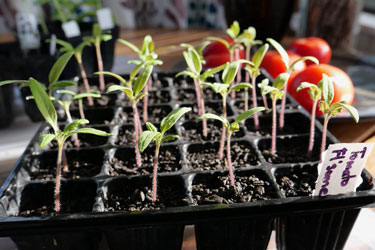
ican Flavoursome tomatoes grown from seed

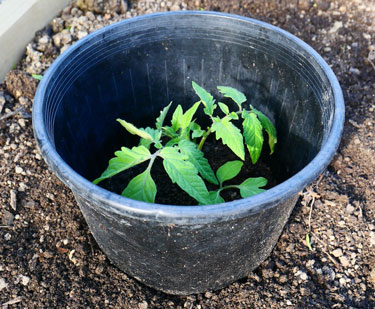
Temporary shelter for a newly planted seedling, using a wide plastic pot with the base removed

Three tomato plants growing in a 35L pot supported by bamboo stakes
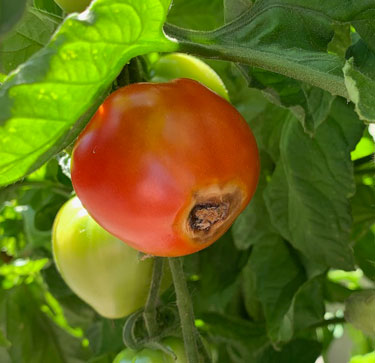
Blossom end rot
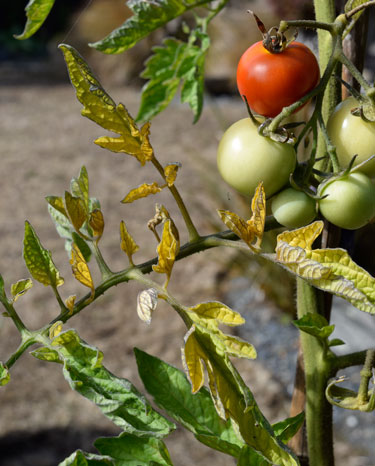
Tomato plant infected with bacterium injected by the tomato-potato psyllid
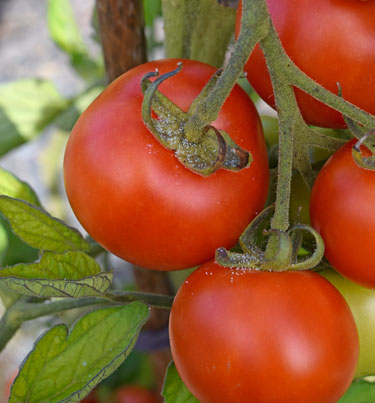
Tomato-potato psyllid 'sugars' on the fruit
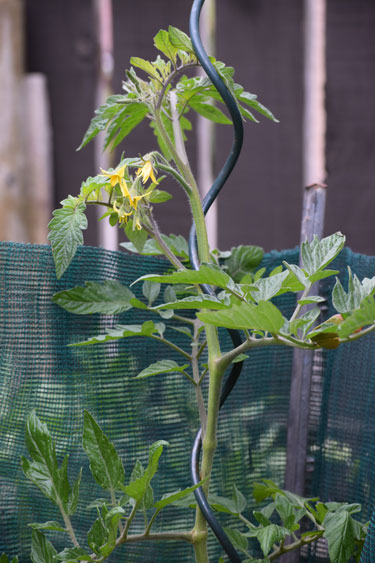
Growing tomato plant supported on spiral stake

